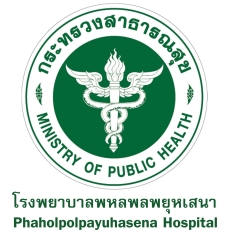ประสิทธิผลของการออกกำลังกายด้วยโยคะต่ออาการปวดหลังส่วนล่างเรื้อรัง
บทคัดย่อ
อาการปวดหลังส่วนล่างเรื้อรังเป็นปัญหาสุขภาพที่สำคัญส่งผลต่อภาวะสุขภาพทั้งด้านร่างกาย จิตใจ เศรษฐกิจ สังคม และคุณภาพชีวิตอย่างต่อเนื่อง การออกกำลังกายแบบโยคะเป็นรูปแบบการออกกำลังกายอีกวิธีหนึ่งที่มีประโยชน์ต่อการลดอาการปวดหลังส่วนล่างอีกทั้งยังช่วยลดภาวะซึมเศร้าได้อีกด้วย การศึกษาครั้งนี้เป็นการศึกษาวิจัยเชิงทดลองแบบสุ่มชนิดมีกลุ่มควบคุม (randomized controlled trial: RCT) มีวัตถุประสงค์เพื่อเปรียบเทียบผลการออกกำลังกายด้วยโยคะกับการออกกำลังกายทั่วไปในผู้ป่วยที่มีอาการปวดหลังส่วนล่างเรื้อรังร่วมกับการรักษาทางกายภาพบำบัดแบบปกติกลุ่มตัวอย่างทั้งหมด 23 รายจะได้รับการสุ่มเพื่อแบ่งเป็นกลุ่มควบคุมได้รับการออกกำลังกายแบบทั่วไปจำนวน12 ราย และกลุ่มทดลองได้รับการออกกำลังกายแบบโยคะจำนวน11 รายโดยแต่ละกลุ่มจะได้รับประเมิน 1.ความปวดด้วย Numeric Pain Rating Scale 2.ความสามารถในการทำกิจกรรมด้วยแบบประเมิน thai version of oswestry questionnaire: ODI และ 5R-STS 3. แบบสอบถามเครื่องชี้วัดคุณภาพชีวิตขององค์การอนามัยโลกชุดย่อ ฉบับภาษาไทย (WHOQOL–BREF– THAI) ก่อนและหลังเข้าร่วมโครงการ ผลการศึกษาพบว่า กลุ่มทดลองมีค่าคะแนนเฉลี่ยความปวดลดลงมากกว่ากลุ่มควบคุมอย่างมีนัยสำคัญทางสถิติ เช่นเดียวกับผลการประเมินการทำกิจกรรมตาม 5R-STS พบว่า กลุ่มทดลองมีค่าเวลาเฉลี่ยลดลงมากกว่ากลุ่มควบคุมอย่างมีนัยสำคัญทางสถิติ ในขณะที่ผลการประเมินตามแบบสอบถามเครื่องชี้วัดคุณภาพชีวิตขององค์การอนามัยโลกชุดย่อฉบับภาษาไทยของทั้งสองกลุ่มไม่มีความแตกต่างกันอย่างมีนัยสำคัญทางสถิติ จึงอาจสรุปได้ว่าการออกกำลังกายแบบโยคะส่งผลให้ผู้ป่วยที่มีอาการปวดหลังส่วนล่างเรื้อรัง มีระดับความเจ็บปวด, ระดับอาการปวดหลังและความสามารถในการทำกิจกรรม ดีกว่าการออกกำลังกายแบบทั่วไป
เอกสารอ้างอิง
Posadzki P, Ernst E. Yoga for low back pain: A systematic review of randomized clinical trials. Clin Rheumatol. 2011;30(9):1257–62.
Hall H, McIntosh G. Low back pain (chronic). BMJ Clin Evid. 2008 Oct 1; 2008.
Biglarian A, Seifi B, Bakhshi E, Mohammad K, Rahgozar M, Karimlou M, et al. Low back pain prevalence and associated factors in Iranian population: Findings from the national health survey. Vol. 2012, Pain Research and Treatment. 2012.
Chen KM, Chen MH, Hong SM, Chao HC, Lin HS, Li CH. Physical fitness of older adults in senior activity centres after 24-week silver yoga exercises. J Clin Nurs. 2008; 17(19).
Waterman BR, Belmont PJ, Schoenfeld AJ. Low back pain in the United States: incidence and risk factors for presentation in the emergency setting. The Spine Journal. 2012 Jan; 12(1):63–70.
Daniel K. Park MF. Low Back Pain. https://orthoinfo.aaos.org/en/diseases--conditions/low-back-pain.2021.
Amano S, Ludin AFM, Clift R, Nakazawa M, Law TD, Rush LJ, et al. Effectiveness of blood flow restricted exercise compared with standard exercise in patients with recurrent low back pain: Study protocol for a randomized controlled trial. Trials. 2016; 17(1).
Ekman M, Jönhagen S, Hunsche E, Jönsson L. Burden of illness of chronic low back pain in Sweden: A cross-sectional, retrospective study in primary care setting. Vol. 30, Spine. 2005.
Grøvle L, Haugen AJ, Keller A, Natvig B, Brox JI, Grotle M. The bothersomeness of sciatica: Patients’ self-report of paresthesia, weakness and leg pain. European Spine Journal. 2010;19(2).
Schaller A, Froboese I. Movement coaching: Study protocol of a randomized controlled trial evaluating effects on physical activity and participation in low back pain patients. BMC MusculoskeletDisord. 2014; 15(1).
อัญชลี คงสมชม, Kongsomchom A, Sudachom W, Janwantanakul P, Unit PT. ปวดหลังเรื้อรัง ต้องทำอย่างไร. 2020; (January): 69–77.
Hamilton DK, Kong C, Hiratzka J, Contag AG, Ailon T, Line B, et al. Patient Satisfaction After Adult Spinal Deformity Surgery Does Not Strongly Correlate With Health-Related Quality of Life Scores, Radiographic Parameters, or Occurrence of Complications. Spine (Phila Pa 1976). 2017 May 15; 42(10): 764–9.
Choi SD, Woletz T. Do Stretching Programs Prevent Work-related Musculoskeletal Disorders? J Saf Health Environ Res. 2010; 6(3).
Clare HA, Adams R, Maher CG. A systematic review of efficacy of McKenzie therapy for spinal pain. Australian Journal of Physiotherapy. 2004; 50(4):209–16.
Namnaqani FI, Mashabi AS, Yaseen KM, Alshehri MA. The effectiveness of McKenzie method compared to manual therapy for treating chronic low back pain: A systematic review. Journal of Musculoskeletal Neuronal Interactions. 2019; 19(4): 492–9.
Purepong N, Jitvimonrat A, Boonyong S, Thaveeratitham P, Pensri P. Effect of flexibility exercise on lumbar angle: A study among non-specific low back pain patients. J Bodyw Mov Ther [Internet]. 2012; 16(2): 236–43. Available from: http://dx.doi.org/10.1016/j.jbmt.2011.08.001
American College of Sports Medicine (Copyright © 2011). ACSM Information On… Selecting and Effectively Using a Yoga Program [Internet]. 2011. Available from: www.acsm.org.
ฉัตรทิราภรณ์ โลหพันธุ์วงศ์., นฤมล นันทพล., วนิดา พันธ์สอาด., สำนักวิทยาศาสตร์การกีฬา. การศึกษาผลของการฝึกโยคะที่มีต่อการพัฒนาทางสุขภาวะของคนไทย [Internet]. สำนักวิทยาศาสตร์การกีฬา สำนักงานพัฒนาการกีฬาและนันทนาการ กระทรวงการท่องเที่ยวและกีฬา; 2550 [cited 2022 Sep 19]. Available from: https://www.dpe.go.th/research-preview-392891791812
Ducharme A. Yoga’s Effect on Pain and Functional Disability in Patients With Chronic Low Back Pain: a Literature Review. 2015; 106. Available from: http://digitalcommons.brockport.edu/honors/106
รุจา แก้วเมืองฝาง, อัญญา ปลดเปลื้อง. ผลของโปรแกรมโยคะต่อความเครียดของนักศึกษาพยาบาลศาสตร์. วารสารมหาจุฬานาครทรรศน์. 2552;2(เมษายน 2562): 642–57.
Tekur P, Singphow C, Nagendra HR, Raghuram N. Effect of short-term intensive yoga program on pain, functional disability and spinal flexibility in chronic low back pain: A randomized control study. Journal of Alternative and Complementary Medicine. 2008; 14(6): 637–44.
Büssing A, Ostermann T, Lüdtke R, Michalsen A. Effects of yoga interventions on pain and pain-associated disability: a meta-analysis. J Pain. 2012 Jan; 13(1): 1–9.
Williams K, Abildso C, Steinberg L, Doyle E, Epstein B, Smith D, et al. Evaluation of the Effectiveness and Efficacy of Iyengar Yoga Therapy on Chronic Low Back Pain. Spine (Phila Pa 1976). 2009 Sep; 34(19): 2066–76.
Saper RB, Boah AR, Keosaian J, Cerrada C, Weinberg J, Sherman KJ. Comparing Once- versus Twice-Weekly Yoga Classes for Chronic Low Back Pain in Predominantly Low Income Minorities: A Randomized Dosing Trial. Evidence-Based Complementary and Alternative Medicine. 2013;2013:1–13.
Cox H, Tilbrook H, Aplin J, Semlyen A, Torgerson D, Trewhela A, et al. A randomised controlled trial of yoga for the treatment of chronic low back pain: Results of a pilot study. Complement Ther Clin Pract. 2010; 16(4).
Galantino M lou, Bzdewka TM, Eissler-Russo JL, Holbrook ML, Mogck EP, Geigle P, et al. The impact of modified hatha yoga on chronic low back pain: A pilot study. Altern Ther Health Med. 2004; 10(2): 56–9.
Hayden JA, van Tulder MW, Malmivaara A v., Koes BW. Meta-analysis: Exercise therapy for nonspecific low back pain. Vol. 142, Annals of Internal Medicine. 2005.
สุรชัย แซ่จึง, ทกมล หรรษาวงศ์ กจ. ความน่าเชื่อถือของแบบสอบถามออสเวสทรีในการประเมินปวดหลัง.pdf. ศรีนครินทร์เวชสาร. 2545; 247–53.
สุวัฒน์ มหัตนิรันดร์กุล และคณะ. เครื่องชี้วัดคุณภาพชีวิตขององค์การอนามัยโลกชุดย่อฉบับภาษาไทย (Whoqol–Bref–Thai). กรมสุขภาพจิต. 2545; 1–8. Available from: http://www.dmh.go.th/search/search_result.asp?cof=FORID%3A11&cx=001360930190496801044%3A4x4-ywjjkg4&q=คุณภาพชีวิต
Jones SE, Kon SSC, Canavan JL, Patel MS, Clark AL, Nolan CM, et al. The five-repetition sit-to-stand test as a functional outcome measure in COPD. Thorax. 2013; 68(11).
Staartjes VE, Schröder ML. The five-repetition sit-to-stand test: Evaluation of a simple and objective tool for the assessment of degenerative pathologies of the lumbar spine. J Neurosurg Spine. 2018; 29(4): 380–7.
Klukowska AM, Schröder ML, Stienen MN, Staartjes VE. Objective functional impairment in lumbar degenerative disease: concurrent validity of the baseline severity stratification for the five-repetition sit-to-stand test. J Neurosurg Spine. 2020; 33(1).
ดาวน์โหลด
เผยแพร่แล้ว
รูปแบบการอ้างอิง
ฉบับ
ประเภทบทความ
สัญญาอนุญาต
ลิขสิทธิ์ (c) 2022 โรงพยาบาลพหลพลพยุหเสนา

อนุญาตภายใต้เงื่อนไข Creative Commons Attribution-NonCommercial-NoDerivatives 4.0 International License.
บทความที่ได้รับการตีพิมพ์เป็นลิขสิทธิ์ของโรงพยาบาลพหลพลพยุหเสนา
ข้อความที่ปรากฏในบทความแต่ละเรื่องในวารสารวิชาการเล่มนี้เป็นความคิดเห็นส่วนตัวของผู้เขียนแต่ละท่านไม่เกี่ยวข้องกับโรงพยาบาลพหลพลพยุหเสนาและบุคลากรท่านอื่น ๆ ในโรงพยาบาลฯ แต่อย่างใด ความรับผิดชอบองค์ประกอบทั้งหมดของบทความแต่ละเรื่องเป็นของผู้เขียนแต่ละท่าน หากมีความผิดพลาดใด ๆ ผู้เขียนแต่ละท่านจะรับผิดชอบบทความของตนเอง





